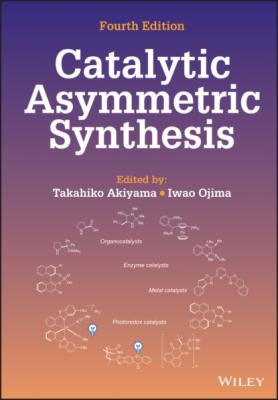Catalytic Asymmetric Synthesis. Группа авторов
Чтение книги онлайн.
Читать онлайн книгу Catalytic Asymmetric Synthesis - Группа авторов страница 73
 example is the addition of cyanide nucleophiles to imine derivatives (Strecker reaction) leading to chiral α‐amino nitriles, which has been extensively studied; the first highly enantioselective phase‐transfer catalyzed version of this reaction was reported by Maruoka in 2006 [59, 60].
example is the addition of cyanide nucleophiles to imine derivatives (Strecker reaction) leading to chiral α‐amino nitriles, which has been extensively studied; the first highly enantioselective phase‐transfer catalyzed version of this reaction was reported by Maruoka in 2006 [59, 60].
4.2.1.4. Arylation
In 2005, Jørgensen reported the first enantioselective SNAr arylation of enolates using chiral phase‐transfer catalysis (Scheme 4.13) [61, 62]. β‐ketoesters could be arylated with activated aryl fluorides using a cinchoninium‐based catalyst. Notably, quaternary carbon centers were formed obviating the potential issue of product racemization.
Scheme 4.12. Enantioselective Mannich reaction using glycine imines.
Scheme 4.13. Enantioselective arylation of 1,3‐dicarbonyl nucleophiles via nucleophilic aromatic substitution.
Source: [61, 62].
In 2014, Maruoka used a similar SNAr PTC strategy to achieve the enantioselective arylation of glycine imine derivatives (Scheme 4.14) [63]. Here, a chiral ammonium catalyst with a biaryl backbone proved to be optimal. This chemistry was further expanded to use electron neutral and electron‐rich aryl electrophiles, activated as Cr(CO)3 complexes [64]. Use of a chiral binaphthyl‐derived ammonium catalyst proved to be optimal in this case.
In a further extension of this work, the arylation of oxindoles with activated aryl fluorides was accomplished using a binaphthyl‐derived chiral phosphonium catalyst (Scheme 4.15) [65].
In recent years, the atropselective synthesis of biaryl motifs using chiral phase‐transfer catalysis has garnered increased attention. In 2014, Smith disclosed the first atropselective SNAr reaction using a dichloropyrimidine electrophile and a thiophenol nucleophile, wherein restricted rotation around the biaryl linkage in the product gives rise to atropisomers (Scheme 4.16) [66]. Moderate to high enantioselectivity is observed using a first‐generation chiral cinchoninium catalyst. Building on this work using the same cinchoninium catalyst and related SNAr strategy, Gustafson later reported in 2018 the kinetic resolution of pyrolopyrimidines [67].
In 2017, Cai reported a chiral phase‐transfer catalyzed atropselective macrocyclization strategy to access (−)‐pterocarine and (−)‐galeon (Scheme 4.17) [68]. A chiral cinchoninium catalyst was found to catalyze the intramolecular SNAr reaction of a phenol with an activated aryl fluoride to obtain the desired macrocyclic product with moderate to good enantioselectivity.
Scheme 4.14. Enantioselective arylation of mono‐alkylated glycine imines via nucleophilic aromatic substitution.
Scheme 4.15. Enantioselective arylation of oxindoles via nucleophilic aromatic substitution.
Source: Based on [65].
4.2.1.5. Carbon‐Heteroatom (C‐X) Bond Formation
The importance of enantioselective carbon‐heteroatom bond‐forming reactions cannot be overstated seeing as C–X (X = halogen, O, N, etc.) bonds are ubiquitous in pharmaceuticals and agrochemicals. Over the years, phase‐transfer catalysis has proven to be a privileged strategy to achieve these transformations. Among the most important factors for the successful implementation of such strategies is the development and use of suitable electrophilic heteroatom transfer reagents.
The strategic incorporation of a fluorine atom in drug discovery can directly impact a molecule’s lipophilicity, modulate the acidity/basicity of neighboring functional groups, and improve potency [69]. Asymmetric fluorination reactions have therefore garnered significant attention from the synthetic community over the last 20 years [70]. In 2002, Kim reported the first example of enantioselective α‐fluorination of β‐ketoesters using phase‐transfer catalysis (Scheme 4.18) [71]. A chiral cinchoninium catalyst was found to promote this reaction with moderate enantioselectivity using NFSI as the electrophilic fluorine source.
Scheme 4.16. Atropselective synthesis of biaryl motifs via nucleophilic aromatic substitution.
Scheme 4.17. Atropselective macrocyclization via nucleophilic aromatic substitution.
Source: Based on [68].
Scheme 4.18. Enantioselective α‐fluorination of β‐ketoesters.
Source: Based on [71].
Scheme 4.19. Enantioselective α‐chlorination and α‐sulfenylation of 1,3‐dicarbonyl nucleophiles.
Source: Based on [72].
Scheme 4.20. Enantioselective